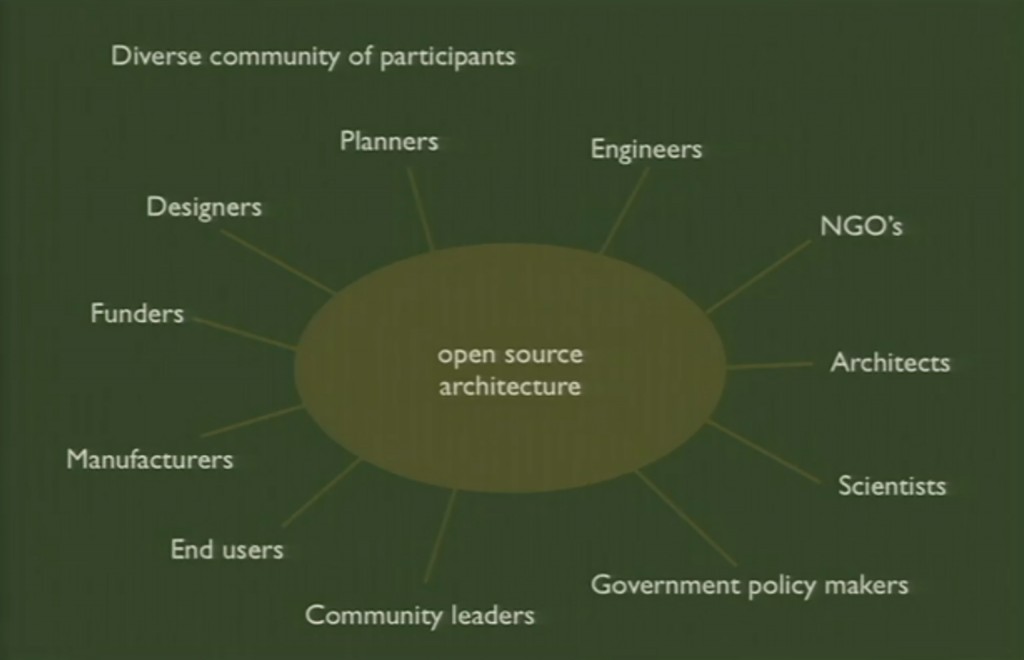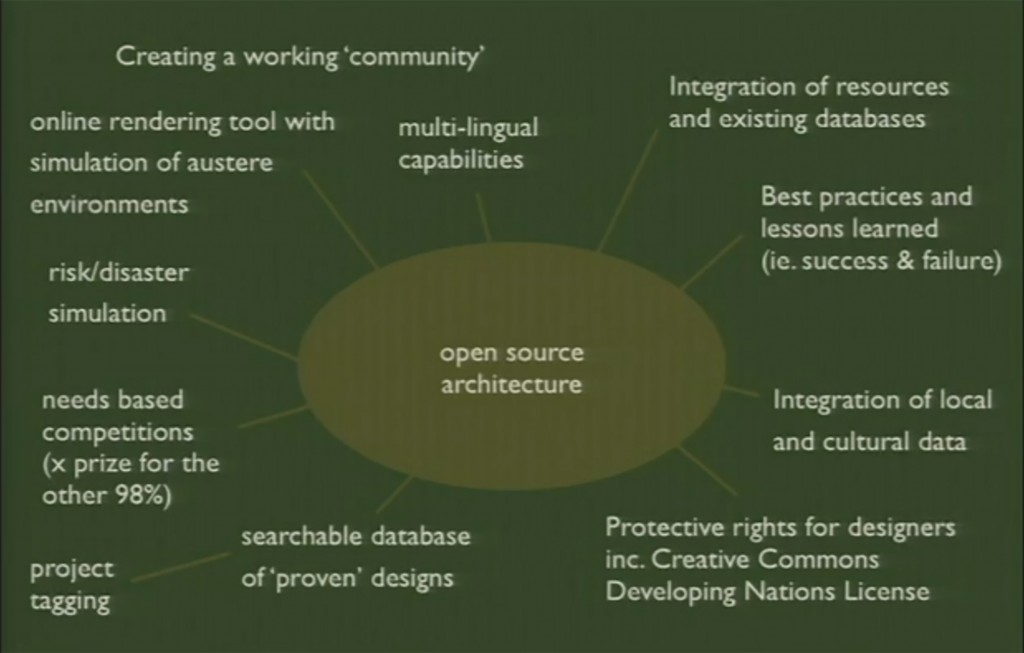Open Source Architecture
Posted by Sneha Srinivasan on November 1, 2014Steven Weber’s book, ”Success of Open Source” led to an animated discussion in class the other day. The class seemed divided on how this model could be successful in any other field other than software and coding. Even though it seemed like a promising phenomenon, for the lack of any concrete examples or models, I came away quite skeptical from the discussion.
Naturally, I was elated when I found an open source model that has been implemented in a field of ‘design’ and which has been working successfully for a few years now. And in none other than … architecture( as it was a field of design that was raised in class multiple times).
Cameron Sinclair – the co-founder of Architecture for Humanity presents a model for open source architecture in his TED talk in 2006. Architecture for Humanity uses the open source network to create sustainable and low-cost housing designs to address the needs for housing in humanitarian challenges.
So what does open source architecture look like?
It starts with a need or a problem that is faced by a community. Anyone can apply to open a chapter with Architecture For Humanity. Open source design completions are held where architects/designers put up their projects. Architecture for Humanity has replaced the traditional Copyright with something called a Creative Commons License for Developing Countries, which allows communities to access their designs, print it out and replicate it in a developing country.
It’s an open network, so it allows free access to view and browse through other peoples projects, comment and discuss on relevant topics, share and collaborate ideas, pool resources and use the given tools and resources to implement these projects where required. This network brings together people from multiple fields: architects, technology professionals, historians, funding partners , policy makers , and the end users to create a match making process for the implementation of these designs.They focus on low-cost sustainable designs, which allows the users to prototype these options at a low cost.
Architectural drawings and plans are supplemented with other interactive parameteric design softwares like Grasshoper and Revit to enable users to navigate and modify designs in order to test out their options before implementation. Architecture for Humanity uses a community-based approach where the end users from the community are allowed to choose which design they want to implement and modify or adapt it to their needs. Experts work with the community and train them in the process of construction.
Trained in architecture, I am constantly assimilating and comparing practices everywhere I go. As a new resident in this country, I was extremely surprised to see how New York has its own share of ‘architectural’ problems and practices; many of which are not sustainable. For instance; this place is blessed with really good weather during the summer, but all the houses are always air-conditioned. It could get warm sometimes, but that could easily be corrected with open windows and a ceiling fan. This may seem naïve and old fashioned but it is way more energy efficient. Secondly, the wooden construction method could have its advantages on quick , easy and modular construction techniques but is there no other alternative to using wood as the main material for construction? I may have come from a developing country, but I have seen several traditional and local innovations in architecture that work beautifully (not implying that there is none here). Glass bottles used to reinforce mud construction, homemade clay refrigeration systems that do not need electricity, parabolic solar cookers etc. And I can vouch that there would be several other innovations existing all around the world.
These ideas and prototypes are meant to be shared, evolved and adapted; to various contexts; based on cultural, climatic, topographic differences and local needs. How can this ‘sharing’ be scaled, so that these ideas could be used and adapted by other parts of the world?
Open Source provides such a platform for this global sharing and interaction of ideas. Since it is on the World Wide Web, it enables instant collaborations beyond the traditional schema of profits. It is possible to compare and optimize solutions for most of the problems that exist in the world. And if it is working for architecture, I argue that this could be employed for all fields of design. Open source is giving us this unique opportunity to tap into the rich and historical accumulation of shared knowledge and I urge us all to grab it.
Bibliography :
- “My Wish : Cameron Sinclair”, TED2006.23.24.Filmed Fed 2006, http://www.ted.com/talks/cameron_sinclair_on_open_source_architecture .
- Cameron Sinclair , “What’s Next: Cameron Sinclair”, World Changing, 28 December, 2006, http://www.worldchanging.com/archives/005690.html .
- ‘Architecture for humanity’, Official Website, http://architectureforhumanity.org.
- ‘Open Source Architecture’, Wikipedia, http://en.wikipedia.org/wiki/Opensource_Architecture .

